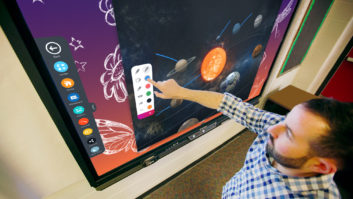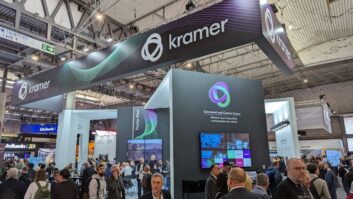
Kramer Electronics has been an innovator in the field of video for 35 years. We talk to its marketing director, David Margolin, about the demands and challenges of the converged AV-IT world.
How did you get into the world of AV technology?
I come from the videoconferencing and unified communications world. In 2012, as part of an Avaya acquisition, I moved from Israel to the US and supported the videoconferencing division’s worldwide marketing. Prior to this, I was the director of marketing at Radvision until it was acquired by Avaya.
As AV and VC reside in the same space and integrate with each other, I was familiar with AV technology. During my time with Radvision, we were already cooperating with Kramer on different levels so I knew the company pretty well.
In my experience, videoconferencing in many senses is moving away from fixed spaces towards a more personalised VC – it’s all about bringing the meetings to the participants, and not the participants to the meeting spaces. In AV, the room or meeting space is where the AV components are physically installed and live, which is one of the key differences between the two industries.
Videoconferencing technologies are mainly software/cloud-based and have been so for several years. Virtualisation and hosted services represent the way for major VC/UC vendors to introduce their solutions. The AV industry is just starting to realise the inherent potential and advantages and we can see the beginnings of a shift towards that. It’s time for the AV industry to rapidly adopt these platforms and introduce the next generation of AV/IP solutions, which will become the new standard.
Tell us about your career at Kramer.
For the past two years, I’ve been managing global marketing at Kramer and reporting directly to the CEO of the company, Dr Kramer. I manage a team of 17 highly talented people, including local marketing staff, who execute our marketing plans and strategies with all our worldwide offices. On a global scale I oversee the marketing activities that are carried out on a local level.
What have been the biggest changes in the AV landscape during that time?
These are exciting times and there’s been a huge change over the past two years.
I feel that we are just at the beginning of an enormous change that will facilitate and accelerate Kramer to achieving new technological breakthroughs and providing the market with many new and exciting solutions and products. Such new products will definitely be impactful in terms of AV over IT and the convergence that our market is going through.
Kramer is definitely on the path to taking a leading role in this change. You’ve probably seen our new and exciting solutions which were designed for the new shift towards AV/IP – such as Kramer Control, a cloud control platform, Kramer Network, an enterprise management platform, and of course our line of streaming technologies for AV over IP.
Furthermore, we have a new product roadmap which will introduce some new and exciting technologies and will accelerate our growth.
Kramer’s stand designs at InfoComm 16 and ISE 2017 positioned the company very strongly as a provider of solutions, potentially with a large software element, rather than black boxes. How has the market responded?
Last year, the company launched a new brand strategy and it all comes together to tell a compelling story about our new AV Beyond the Box strategy. This is our new path towards software, cloud and smart hardware. This story challenges the traditional big-box AV market with their proprietary products in which they are so heavily invested. Kramer has adopted a different approach with smarter solutions that provide a better answer to any challenge – with better customer value.
Since the market is moving to new owners, who are IT people, there is a tangible market need for solutions that are much more flexible and that can be easily installed and maintained. On top of the move from proprietary hardware (big boxes) to software and cloud, even the hardware should be managed in the same way that it is in typical IT installations. IT professionals who own AV expect to understand, manage and support their AV installation the same way as they do any IT installation they deal with.
IT professionals dealing with critical systems are always on alert and looking for solutions that enable them to get back to service and minimise downtime. The same approach and work methodology should be applied when dealing with AV installations. So when a meeting room goes down, it’s very similar to when a telephony system stops working. They should be treated as equally critical pieces that must be handled and supported in a simple and a quick way. For an IT person, not being able to get a meeting room working, and waiting for a control-brain programmer to replace a broken box, is a big frustration.
At Kramer we understand these pain points and are introducing AV solutions designed for the IT professional. We’ll see more of that in the coming months.
Kramer’s presence at InfoComm 16 and ISE 2017 was an introduction to where the company is going. The response we received was phenomenal, especially with regard to Kramer Control and Kramer Network. Both traditional AV and IT industries are very excited and eager to start using these tools with their approach to software, flexibility, and conformity to typical IT installation methodology.
As a part of our move towards software, we introduced a virtual matrix-based solution using new high-performance encoders/decoders. We also launched VIA wireless collaboration as a software-only solution which ties in nicely with this strategy and demonstrates our move from proprietary hardware to software-based services.
Which have been the fastest market sectors to move to IP-based solutions, and which the slowest? And are there any applications for which point-to-point solutions will always be preferable to networked ones?
The move from big to small boxes and from standard AV to IP-driven technology is inevitable. This is where the market is going and we’ll first see these technologies being adopted in smaller-scale applications.
We know that the market needs simple solutions. Moving towards IT technology will become the new AV standard eventually. Aside from the big and complex AV installations, the new AV owners are still looking for simple solutions for smaller meeting spaces that don’t require a high level of technology but do require remote management. Being able to identify, before the end user, that there’s an issue with the meeting space is a key requirement. On top of that, being able to minimise downtime and provide a reliable user experience is equally important.
The Kramer Maestro software feature, which is a planned addition to many standard Kramer products, is a good example of how we can take a simple unit that can accomplish a sophisticated set of actions and deliver a complete automated meeting room experience. This is a standard AV installation that can generate complex actions but with minimal human intervention. Connecting a cable or just entering a room is all it takes to get your room/space ready for a meeting. On the AV or IT professional side, there’s the ability for remote management and control adjustments – all done without any coding/programming.
Do you have a favourite current Kramer product or one that you think encapsulates the best of what Kramer does in 2017?
It’s hard to choose one product. I can definitely say that three of my favourite products are Kramer Network, our enterprise management platform with its virtual matrix; Kramer Control, our cloud-driven control technology; and our VIA wireless collaboration and presentation product line which can now also be delivered as a software-only solution.
Take VIA for example. In many ways, this is the story of where this industry is going. You can connect wirelessly from any device, making it a perfect wireless presentation solution. But the more exciting part is the collaboration features it offers for the user. The connected world and how people are using technology these days is basically setting new standards and the ability to experience and use any device, for example, is just one important element. The move towards IT sectors also dictates the delivery of highly secured solutions which aren’t susceptible to hacking.
Is the industry doing enough to recruit the next generation of AV engineers and technicians?
There’s a shortage of people in the industry. The AV industry is mistakenly considered as a less attractive industry to work in. It is considered an older industry, but if you look at what AV brings today, it’s as sophisticated and exciting as the rest.
Kramer has started its own recruitment initiative and at ISE 2017 we were looking for talented people to globally support our growth. As we grow and evolve technologically we are looking for the right people who will develop the next generation of products and have an impact on what the AV market will look like in the upcoming years.
Do you have any unfulfilled ambitions?
After catching my breath from ISE, my personal aspiration going forward is to harness marketing to reinforce and contribute to Kramer growth on a larger scale – we see a large impact coming from effective and measurable marketing efforts. My ambition is to deliver the right message and provide effective sales and marketing tools to our staff.
On a more practical level, we will invest more into online technologies and platforms to promote sales and generate demand. Increasing the online footprint and awareness of the company and going after new vertical markets are key activities that we’ll manage.







